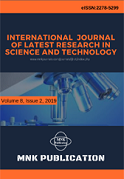DOI:10.29111/ijlrst ISRA Impact Factor:3.35, Peer-reviewed, Open-access Journal
Research Paper Open Access
International Journal of Latest Research in Science and Technology Vol.3 Issue 2, pp 19-24,Year 2014
Correspondence should be addressed to :
Received : 17 March 2014; Accepted : 28 March 2014 ; Published : 30 April 2014

| Download | 125 |
|---|---|
| View | 177 |
| Article No. | 10270 |
Plant productivity is determined by two main interrelated factors, namely, the application of technical culture factor, including the use of superior plant materials, and soil suitability factor. Therefore, it was necessary to conduct a research that aimed at finding out the actual productivity of oil palm plantations cultivated and properness of the application of technical culture carried out, and relationship between the application of technical culture and productivity achieved at the level of land suitability of the cultivated land. The study was conducted by taking samples from five oil palm plantations in East Kalimantan with a total area of 85,000 ha ±. The research used primary and secondary data related to the aspects of production, technical culture and land suitability. The secondary data were collected through studies on the enterprises’ reports and research results whereas the primary data were collected by direct observation and measurement of the fields, and then the data were analyzed using statistical analysis. The results showed that the productivity of FFB and CPO produced by the oil palm enterprises in the area of research is still low when compared to the potential baseline of productivity of land with the same suitability classification (S3 or Marginally Suitable) where the FFB productivity reached 78.96% and CPO productivity reached 76.63% of the potential baseline of the productivity of S3 Land Suitability Classification (LSC). The low level of productivity is thought to be caused by the level of application of technical culture which has not met the baseline of the recommended standards of technical culture where the technical culture application errors occurred ranged from 0.05 to 7.58%, and the estimated effect toward the decline in production reached up to 65%. The technical culture application errors occurred in the nursery stage, immature plants (TBM) and mature plants (TM).
Copyright © 2014 Rusli Anwar et al. This is an open access article distributed under the Creative Commons Attribution 4.0 International (CC BY 4.0) license which permits unrestricted use, distribution, and reproduction in any medium, provided the original work is properly cited.
Rusli Anwar, Santun R.P Sitorus, Anas Miftah Fauzi, Widiatmaka, Machfud. , " Technical Culture And Productivity Of Oil Palm In Several Plantations In East Kalimantan ", International Journal of Latest Research in Science and Technology . Vol. 3, Issue 2, pp 19-24 , 2014

MNK Publication was founded in 2012 to upholder revolutionary ideas that would advance the research and practice of business and management. Today, we comply with to advance fresh thinking in latest scientific fields where we think we can make a real difference and growth now also including medical and social care, education,management and engineering.

We offers several opportunities for partnership and tie-up with individual, corporate and organizational level. We are working on the open access platform. Editors, authors, readers, librarians and conference organizer can work together. We are giving open opportunities to all. Our team is always willing to work and collaborate to promote open access publication.

Our Journals provide one of the strongest International open access platform for research communities. Our conference proceeding services provide conference organizers a privileged platform for publishing extended conference papers as journal publications. It is deliberated to disseminate scientific research and to establish long term International collaborations and partnerships with academic communities and conference organizers.